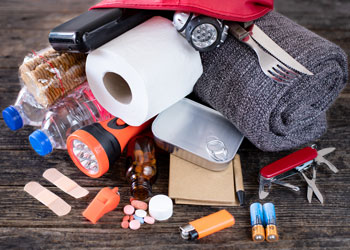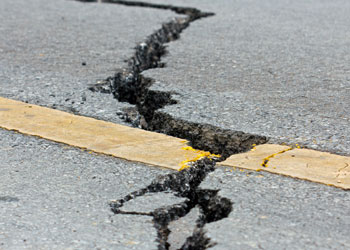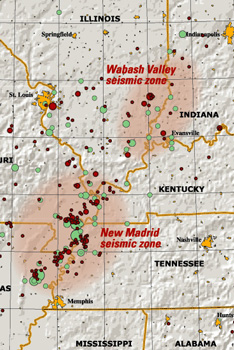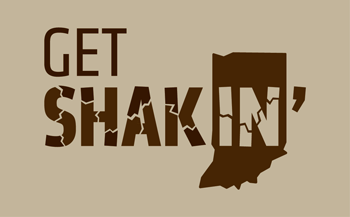Earthquakes
- Get Prepared
- Nature Safety
- Current: Earthquakes
The third Thursday in October is International ShakeOut Day.
February is Earthquake Awareness Month for the Central United States.
Drop, Cover and Hold On
Indiana is near two major seismic zones, and earthquake activity has been recorded in the area. Scientists expect incidents similar to the 1811–1812 New Madrid earthquakes will impact Indiana again. These natural disasters cannot be prevented, so preparedness is vital.
Drop, Cover and Hold On
Earthquake Safety Tips
Quick Tips
- Earthquakes can occur any time of the day. Plan ahead for addressing an emergency during a work or school day.
- Create and practice a household reunification plan. Include designated contact information and a meeting location.
- During an earthquake, take shelter under sturdy furniture and hold onto it.
- If you are inside during an earthquake, stay inside.
- If there is a hissing sound or smell of gas, immediately leave the area.

Before an Earthquake
Earthquakes occur at any time and season without any notice. Be ready for every stage of the incident by taking the time to prepare before an emergency.
- Create a waterproof disaster kit. The kit should support each person a minimum of seven days.
- Create a list of emergency phone numbers.
- Designate a meeting place away from the home and any collapsible structures.
- Earthquakes can occur any time of the day. Plan ahead for addressing an emergency during a work or school day.
- Create and practice a household reunification plan. Include designated contact information and a meeting location.
- Learn how to turn off water, gas and electricity supplies to the home from the main shut-off valve or switch. Contact the local utility company on how to properly turn off the lines.
- Practice Drop, Cover and Hold On with every household member and coworker.
- Place heavy objects on low shelves and light objects on top shelves.
- Secure heavy furniture such as bookcases, hanging TVs, kitchen appliances, air conditioners, furnaces and water heaters. Wall anchors are now commercially available and easy to install.
- If possible, have walls, chimneys, windows and foundations reinforced. Stronger structures better withstand the shocks of an earthquake.
- Consider purchasing earthquake insurance policies for homes, rental properties and businesses. Insurance coverage and prices can vary.

During an Earthquake
Remembering to Drop, Cover and Hold On when an earthquake begins is important, but staying safe is possible if that process cannot be followed.
- Take shelter under sturdy furniture and hold onto it. The furniture will help protect against any falling debris.
- Cover the head and neck with arms.
- If outside, stay away from power lines, tall buildings, falling rocks or anything that could collapse.
- If in a vehicle, drive slowly to a location away from buildings, overpasses, underpasses and utility wires.
- If in a building or enclosed structure, never go outside.
- People with mobility disabilities should also seek cover (watch this video or follow these pictures).

After an Earthquake
The time following an earthquake can be dangerous because of potential fires, damaged buildings and other hazards. Broken glass and debris also create major concerns for potential injuries.
- Be prepared for aftershocks, which are smaller earthquakes that can follow for days to years after the main earthquake.
- Never use elevators to evacuate a building. If the power goes out, occupants will be trapped.
- Monitor local news radio, TV or social media postings for additional information or instructions from local officials.
- To prevent potential injury or death, do not re-enter a building with structural damage.
- If there is a hissing sound or smell of gas, immediately leave the area.
- Phone calls should be saved for emergencies. Phone wires may be damaged and have limited access.
- Check for injuries and care for those seriously injured.
Resources
Websites
- Central U.S. Earthquake Guide
Central U.S. Earthquake Consortium - Earthquakes
Ready.gov - Earthquake Hazards
U.S. Geological Survey - Earthquake Hazards Map
Central U.S. Earthquake Consortium - Earthquake Safety
American Red Cross - Earthquake Safety Video Series
Great ShakeOut - Indiana Earthquakes
Indiana Geological & Water Survey - ShakeOut Resources
Central U.S. Earthquake Consortium - Without Warning! Comic Book
Indiana Department of Homeland Security
Disaster Kits
Hoosiers should be prepared with a household emergency or disaster kit because disasters, including earthquakes, could result in disruptions to everyday life. Depending on the severity of a disaster, a household could need supplies for three days — or more — until emergency personnel can help.
Some of the basic supplies that should be included in a kit:
- Non-perishable food
- Water
- First aid kit
- Battery-powered or hand-crank radio
- Flashlight
- Batteries
- Local maps
- Extra clothing
Learn more about disaster kits at the Disaster Kit page or at the National Preparedness Month page (Week 2 - Build a Kit).


Seismic Zones
Wabash Valley Seismic Zone
The Wabash Valley Seismic Zone is located in southwestern Indiana and southeastern Illinois. Read a possible scenario if a 6.5 magnitude earthquake were to occur in this zone
New Madrid Seismic Zone
The New Madrid Seismic Zone is located along the Mississippi River Valley from Illinois to Tennessee. Learn more about this fault line

Get ShakIN'
Get ShakIN' was a public awareness campaign by the Indiana Department of Homeland Security to inform Hoosiers about the risk earthquakes pose in Indiana and to help them be prepared.
